News
Dewata Beach, where waves of discontent are mounting
View(s):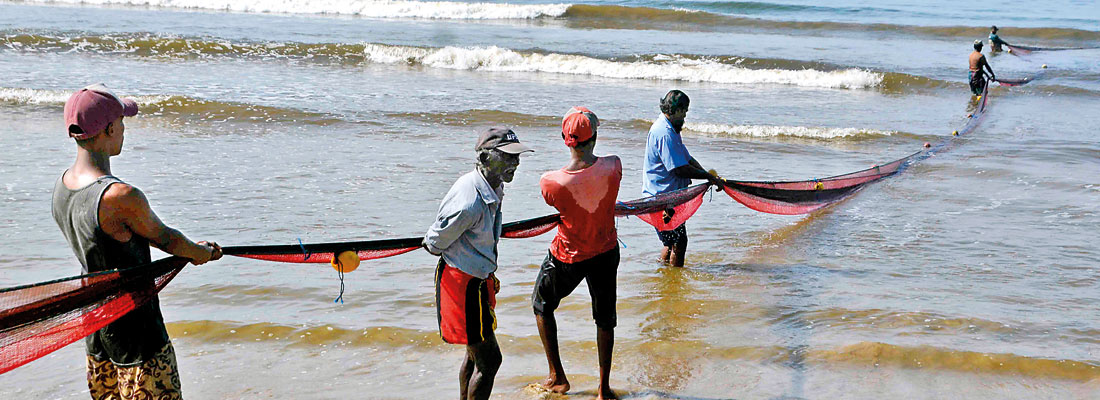
Fishermen pulling in beach seines on Dewata beach. Pix by Priyanka Samaraweera
- Proposed port city project in Galle
The recent release of a new supplementary Environment Impact Assessment (EIA), reviving the on and off Galle Port Development Project, has raised concerns that the proposed reclamation of 40 hectares, would affect the fishing community and a thriving surfing business that brings tourism to the area.Tharushi Weerasinghe reports from Galle
Dewata Beach stretches for about a kilometre along Sri Lanka’s southern coast, the first glimpse of sea and sand for those leaving the Southern Expressway at Pinnaduwa.
On Thursday, at 9 a.m., the Sunday Times arrived to find fishermen pulling in beach seines, their calls carrying over the waves. Occasionally, a tourist joined the effort.
Further along, a row of eateries and surf schools served the steady flow of visitors drawn to the waves. The recent release of a new supplementary Environment Impact Assessment (EIA) reviving the on again and off again Galle Port Development Project received backlash as a new element to the port, the reclamation of 40 hectares, would make drastic geographic interventions to the Dewata Beach.
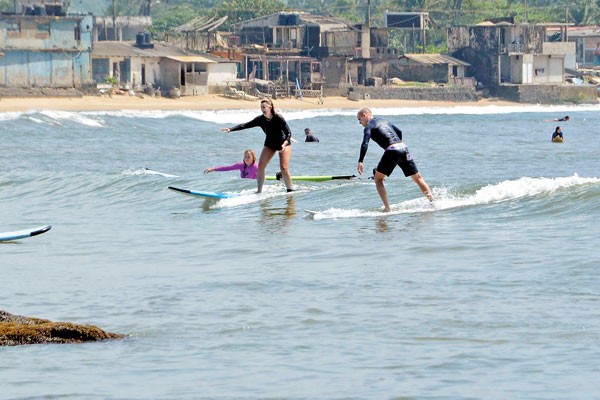
The waves at Dewata are among the most surfer-friendly in the South, particularly for beginners
“The project would end our fishing completely because so much of the beach will be filled in,” said Mohammad Saleem Saleeth, the Chairman of the Dewata Fisheries Association. He has been fishing here for 35 years and comes from generations of fishermen along the same beach first recorded in the 1940s, the seine fishing there was gazetted in 1987.
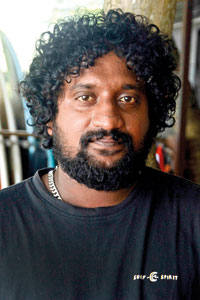
Dushan: Working at a restaurant
He noted that when the fishermen were initially informed of the project by the harbour master about six years ago, they were told that their business would only be disrupted for 2/5 of the construction period after which they would be able to go back to fishing. “We believe this is nonsensical because filling the sea and building breakwaters will stop the waves and the fish will be able to see us coming and realistically I do not believe that they will allow us to fish at a location with luxury boats docked.” Mr. Saleeth said that the community had come to the decision that they would stop fishing altogether if the project does happen and have communicated to authorities that the compensation they receive should reflect that fairly.
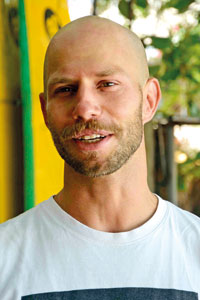
Kacper Reszkea from Poland: Manages a restaurant/surf school
The last time the fishing community here had any communications about the project was about one and a half years ago, according to Mr. Saleeth who claimed that the Ministry of Environment had visited them for some data collection. They have not been visited by any members of an EIA report team.
Mr. Saleeth added that the government should ensure that the benefits and opportunities from the project should include people whose livelihoods currently depend on the beach and not outsiders who “come and colonise” the area.
“We do not expect to oppose the government but only ask that we be given justice for what the fishing community will lose and for a system for the existing tourist industry along the shore to sustain,” he noted.
Many of the restaurateurs and surf instructors along the beach vehemently oppose the construction of the port.
“It makes no sense to me why we are not consulted before expensive tender procedures are activated for projects like this,” said Sandaroo Kumarasinghe, a 33 year-old lawyer turned business owner that runs a cafe along the beach. He claimed that around 500 tourists visit the location every day with consistent business coming in all year round. “A 22-year-old who works for me earns about Rs.80,000 per month which is more than what most professionals earn nowadays and it empowers this entire community as a result,” he insisted. Mr. Kumarasinghe noted that the businesses had collectively approached Minister Vijitha Herath to have an audience with the Sri Lanka Port Authority and relevant ministers to discuss what solutions can be found. He notes that he would be open to the concept if the relevant training and assurances of their business surviving the reclamation were made but feels that the needs are contradictory since business is based on the prevalence of waves for surfing.
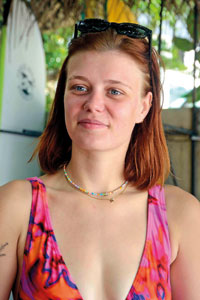
Cato Wessaert from Belgium
“The businesses here will cease to exist if the port comes in because that is not what our guests come to enjoy, they come here to enjoy the natural beauty of this place,” said Kacper Reszkea, from Poland who manages a restaurant/surf school on the shore. If Dewata was to be removed, the closest surf areas are Weligama and Ahangama which are seasonal, he observed. Dewata Beach is the last standing beach in Galle that allows direct access to the waves. “As a foreigner who is investing in this country, I feel like it would be very sad to lose this beautiful place like this and for Dewata losing its waves would mean losing a big part of its identity.”
The waves at Dewata are among the most surfer-friendly in the South, particularly for beginners, who make up the majority of tourists to the area. “This is a place where anyone can surf year-round, and it sustains the lives of so many poor boys and their families,” said a 46-year-old surf instructor known along the shoreline as “Loku.” He questioned why the government would consider disrupting such a unique natural formation as Dewata’s cove. Highlighting the safety of the location, Loku explained that, unlike other surf spots, Dewata’s waves lack the hazards of corals or rocks, making it one of the safest surf destinations in the country. He appealed to the authorities, emphasising that the loss of Dewata’s ecosystem and community would not only harm the country’s tourism but also devastate the livelihoods of those who depend on it.
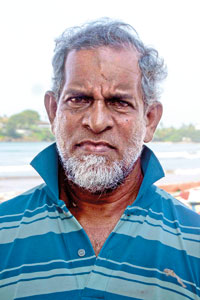
Mohammad Saleem Saleeth, the Chairman of the Dewata Fisheries Association
“In just my workplace alone about 30 people work and earn a good income,” said 35-year-old Dushan who says he has been working here for about 14 years now. He notes that most of the employees along the shore are from low-income families who cannot go abroad and earn. “Apart from the fact that this sustains a lot of tourism it is also one of the few places that is still in its natural state, so I am asking the government to please rethink this project,” he said.
The Sunday Times also interviewed some tourists who were on location. “We come here specifically for the beaches and I feel that it would ruin what is like such a wonder to me, luxury yachts are not that much of a novelty compared to a beach like this,” noted 28 year-old Gabriel Demoulliers from France.
Another 26 year-old from Belgium, Cato Wessaert felt that luxurious “touristy” spectacles would not entice a visit again from her the same way the idea of surfing has. “It would be very unfortunate if the government was to take away the natural beauty and charm this place has.”
“People come to Galle for its historical significance and nature, and we are risking a lot if we lose it,” said 94-year-old Dulantha Gamage Piyasena who owns the renowned VOC Cafe inside the Galle Fort. He felt that the pollution and gentrification that will come about will kill Galle’s old world charm that is still accessible to locals. He also did not believe that the luxury focused clientele would be interested in the trinkets and joys Galle had to offer.
Business owners on the other side of the water felt differently. A 40-year-old restauranter on Jungle Beach felt that the port would bring in more high spending tourists. “Right now we do not get visitors who are willing to spend much because we are primarily known as a low budget location, so the yachts would bring in more revenue if these visitors come to our locations,” he noted.
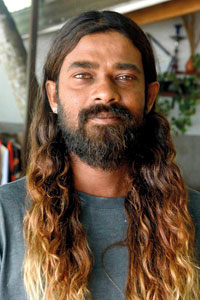
Loku: Surf instructor
The Galle Port Development Project falls under the Sri Lanka Ports Authority (SLPA) with the Coastal Conservation and Resource Management Department (CCD) as the approving authority. Director General R.A.S. Ranawaka spoke with the Sunday Times and noted that an initial project Environment Impact Assessment was approved by the CCD in 2009.
“At that time, we opened the project for public comments, established mitigation measures, and granted approval.Since then, the approvals have been periodically renewed.”
In 2022, a plan for an additional reclamation of 40 hectares along Dewata Beach was introduced. “Once the permits for environmental approval were submitted, we processed them with a stakeholder scoping committee, which determined that a supplementary EIA was required and this process took some time to complete,” the Director General further noted .
The Central Engineering Consultancy Bureau conducted the Supplementary Environment Impact Assessment for the proposed reclamation which was completed in October this year. This report will now be presented to a Technical Evaluation Committee of the CCD. The report has also been opened for public comments, according to the director general, who invited the public to send their written comments to the CCD office. “Once all these comments from the TEC and the public come in, we will present them to the SLPA which will then have to address all the issues raised.
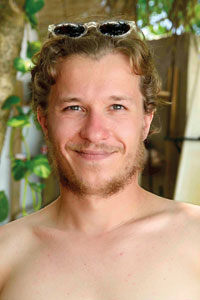
Gabriel Demoulliers from France
The EIA report will be open for public comment for 30 days ending in the first week of January.
The EIA has been conducted and will now be presented to the Technical Evaluation Committee (TEC) again. The comments from this review will be forwarded to the (SLPA, which will need to address any gaps and issues identified. Once these concerns are resolved, we will then apply for approval from other relevant agencies, such as the Urban Development Authority (UDA), to ensure alignment with their Galle Planning, including a traffic assessment report, wildlife clearance, and archaeological impact assessment.
The EIA report has been opened for public comments, with the necessary approvals in place. The Archaeological Department must conduct its own impact assessment, as only the basic clearance has been granted so far.
“There are no significant concerns from our end based on the report so far but the Wildlife Conservation Department has a major role to play in making accurate assessments especially since there is an adjacent sanctuary in Rumassala.”
All of these assessments and reviews will be presented to the SLPA again for their review and response. After addressing these comments, the Technical Evaluation Committee will review the revised plans, and the SLPA will need to respond once more. “Following this, we will conduct another round of consultations to approve the responses received.” Once this final round of approvals is granted, the Advisory Council in the department will be convened for concurrence.
Eng. Ranawaka believed that the entire process would take a few months and final approval from the CCD, if it is given, will only be given once all these checkpoints are passed.
He further noted that the SEIA conducting agency had claimed that public opinion was factored into the studies conducted, “The EIA consulting company is responsible for engaging with the local community, and while we do not directly verify this, we expect them to conduct the process correctly.” However the Sunday Times could not find any party that had been consulted by the CECB.
“There is a conflict of interest in the fact that the SEIA was also conducted by a government affiliated agency,” noted Prof. Terney Pradeep Kumar, a senior lecturer on oceanography at the University of Ruhuna. He noted that he had initially been against the idea of a port development on the basis that it would not be suitable for the Dewata location. “The Bona Vista Coral Reef is also in the same area which needs to be dealt with extremely delicately,” he noted. He added however that since the SEIA was just released a closer look is required into the exact area of impact in light of the new reclamation happening. “In any case the area cannot host a large harbour for cargo ships because it would disturb the ecosystems too much, so at best it can be a port for smaller boats and yachts.”
At present the plan includes 2 offshore breakwaters having the lengths of 850m and 150m, a cruise berth of the length 150m, with a draft of 12.5 m to accommodate large cruise vessels and a state-of-art cruise terminal. The permission for these developments has been obtained by the SLPA. In addition to the development of the above facilities, a land area of 44.97 hectares (ha) (approximately 45 ha) is also to be reclaimed within the Bay of Galle to facilitate infrastructure/real estate developments associated with recreational/tourism activities the SEIA for which is what stirred the recent controversy.
The best way to say that you found the home of your dreams is by finding it on Hitad.lk. We have listings for apartments for sale or rent in Sri Lanka, no matter what locale you're looking for! Whether you live in Colombo, Galle, Kandy, Matara, Jaffna and more - we've got them all!

